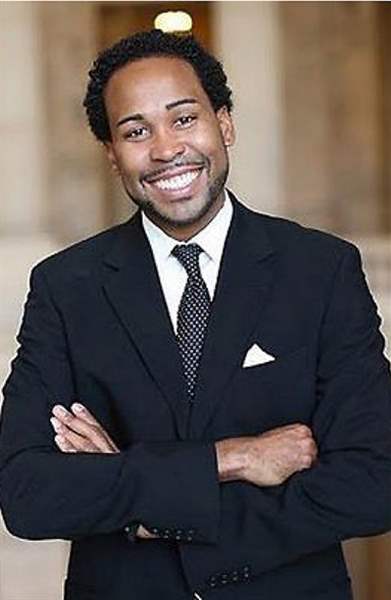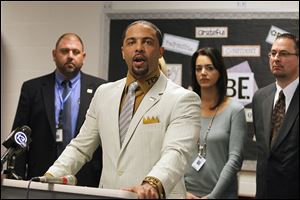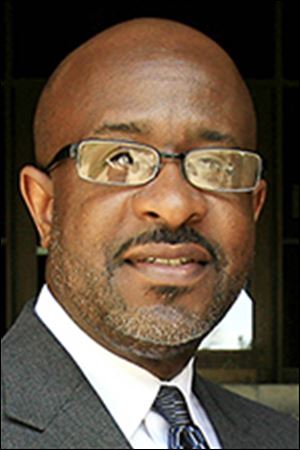
Forum to address minority gap in education system
Community members gather at UT to find solutions, fight ambivalence
1/5/2014
David J. Johns of the White House Initiative on Educational Excellence for African-Americans will be keynote speaker.

David J. Johns of the White House Initiative on Educational Excellence for African-Americans will be keynote speaker.
The achievement gap — the disparity in academic achievement between white and minority students — is so persistent, has been around so long, that it often elicits little more than a shrug, a collective “what can you do,” an acceptance that it’s inevitable, unchangeable, not worth the resources or fight.
But while many accept the gap, others continue to fight to close it.
In Toledo and across the country, African-American students on average perform below their white peers. In Toledo Public Schools, the graduation rate for white students was 11 percentage points higher than for African-American students — 72 percent compared to 61 percent — on the most recent state report card.
At the University of Toledo, about half of all white students who enrolled in 2007 graduated within six years. Less than 20 percent of black students who entered UT in 2007 graduated in the same span.
Part of a cycle. Many individual tragedies. A misleading narrative. The result of institutional power imbalances. Racism. Wasted potential.

Tracee Ellis, chairman of the Toledo Community Coalition’s education task force, called this gap between white and minority achievement an educational crisis.
“Retention may be low for African-Americans, but it also affects overall retention,” said Ms. Ellis, who also oversees the city’s Block Watch program. “We all pay the price for that.”
On Thursday, community members will gather to seek ways to combat that gap. The second Changing Minds, Changing Lives forum will begin at 7 p.m. in the University of Toledo’s Nitschke Auditorium. The event is sponsored by the Toledo Community Coalition and The Blade, part of a series of forums meant to combat racism.
The first forum was in September at Woodward High School auditorium and featured Tim Wise, who has written about white privilege and institutional racism.
The keynote speaker at Thursday’s forum will be David J. Johns, the executive director of the White House Initiative on Educational Excellence for African-Americans. The initiative focuses on improving access to high-quality education for African-American students in an attempt to reduce the achievement gap with white students.

TPS Super-intendent Romules Durant likes to say that the best intervention to help level the educational field between minority and white students is prevention.
Changing narrative
Though he’s the keynote speaker, Mr. Johns said he’s more focused on learning about what’s been successful in Toledo and where the federal government may be able to help.
But he’s also looking to help change the narrative about education in America.
“Too often, when people think about education and African-American students, it’s often negative,” he said.
Conversations about the achievement gap between white and minority students, coupled with high dropout rates, lead many to see the gap as insurmountable, an inevitable disparity that they cannot fix. Since there is no solution, there’s no reason to try to help.
“Too many watch the news and think there’s nothing we can do to help students,” Mr. Johns said.
Much of the achievement gap can be tied tightly to poverty rates. While consternation is often expressed about American students’ performance compared to peers in other countries, students in wealthier suburbs perform equal to or better than heralded Asian and Scandinavian countries. The difference is that those countries don’t have America’s pronounced “doughnut holes” in its cities, the concentration of intense poverty American central cities often face.

McKether
Poverty’s impact
At a recent American Federation of Teachers presentation in Toledo, the group discussed how Americans have trailed other developed countries for decades. It’s not a new problem.
And while children of all races grow up in poverty, it’s impossible to ignore the historical and structural links and causes between poverty, class, and race.
The conversation is right up TPS Superintendent Romules Durant’s alley. His doctoral dissertation was focused on the collective impact of the many facets and results of poverty on education and on the need for community solutions.
So it’s not surprising two key initiatives during the superintendent’s nascent term have been expanding community hub programs at TPS schools and his involvement in a communitywide application for a federal Head Start grant that would focus on intensive support for children from birth through kindergarten.
Disparities between children in poverty and their better-off peers appear soon after birth, meaning the achievement gap forms well before a student steps foot into school. The best intervention, Mr. Durant likes to say, is prevention.
“You either are going to pay for it on the front end,” he said, “or on the back end with probation officers.”
Collective action
Mr. Johns is also a proponent of collective action and community support for students.
Too often, minority students have less access to high-quality early childhood education options. The White House initiative is hoping to share best practices nationwide that would improve the quality of the programs that are available.
But in some ways, Mr. Johns rejects the narrative, because drawing such a strong link between poverty and race and academic achievement can feed the sense of the inevitability of failure.
And just saying the achievement gap is a poverty problem ignores both the complexity of the situation and individual environments. For instance, black youths in rural areas may live in poverty but face different issues than students in central cities, Mr. Johns said. Each city, while having similarities, has its own unique challenges.
Students in New York City may have more access than students in Rust Belt cities to after-school activities and social services because while individual neighborhoods may face extreme poverty, there’s significant wealth in the city that can help fund initiatives.
“There are ways in which a very complex conversation around supporting students from birth through third grade becomes overly simplified,” he said.
That’s not to say that Mr. Johns doesn’t acknowledge the negative impact of poverty on children.
Concentrated poverty brings many ills beyond just lack of resources. The stress of growing up in a distressed neighborhood can be traumatic.
Researchers have started to show, for instance, how many children may have suffered some form of post-traumatic stress disorder from experiencing, witnessing, or perpetrating violence at a young age.
Cultural issue
At the same time, UT anthropology professor Willie McKether said educators have to acknowledge that specific cultural differences and institutional power — or lack thereof — affect minority students in specific ways.
Many African-American students, for instance, learn little if any history in school about African-Americans, and cultural expectations within schools are often white-centric. Black and Latino history and culture are rarely covered at more than a surface level in schools, he said.
“I think that teachers need to be taught, as a part of their undergraduate curriculum, the importance of race and culture and ethnicity, and how that has implication on learning,” he said.
Mr. McKether said he struggled in school until he took his first civil rights course, which changed his whole perspective on the importance of education. Mr. McKether is a leader of an initiative started in recent years by UT staff called Brothers on the Rise. The group holds discussion sessions with minority students where they can talk frankly about their concerns and trepidation about what it means to be an African-American or Latino college student.
Mr. McKether said his work with college students has led him to believe that more needs to be done earlier. Many African-American students come to UT unprepared and feel as if they don’t belong in college. They don’t realize they can ask for help, or don’t even know how to do so.
For many students, he said, their goal was simply to make it into college. Many never thought about what it would take to graduate.
Mentor programs
A focus that Mr. Johns is developing calls for mentors for black students. That’s an area where Toledo may be becoming a leader.
At the first forum, Mr. Durant said about 50 Young Men and Women of Excellence members served as greeters and district ambassadors. The peer mentorship and leadership group led by Mr. Durant has grown strongly.
In some cases, the groups serve as pseudo fraternities and sororities, offering networking opportunities for students. In others, they serve as anti-gang initiatives. Students learn to have high expectations for themselves and to hold their peers accountable for their actions.
Mr. Durant said he hopes to bring more, possibly 100, members to this forum.
Mr. McKether also said a partnership is eyed between Mr. Durant’s groups and UT.
At the university, leaders of Brothers on the Rise helped resurrect the Association of Black Faculty and Staff. Instead of leaving the problem up to the university, he said, staff realized they had to become more engaged with students.
The White House initiative is also focused on highlighting data that better frames the debate, Mr. Johns said. For example, he said, the common misnomer is that more black men are in prison than in college. The belief perpetuates the idea that black students are likely to fail and thus are helpless.
There’s also the asterisk problem. Even when African-Americans succeed, the narrative often includes an element of “this person is an exception.” Thus, even a positive individual story remains a negative story about a group.
Teacher diversity
At the same time, Mr. McKether called that argument a slippery slope. Not acknowledging the institutional forces a student may face — be they poverty or a lack of cultural connection between student and school — can diminish the class and social issues that contribute to the achievement gap.
An example is the incessant difficulty school districts face in diversifying their teaching ranks to be representative of their students.
About 88 percent of TPS teachers are white, though only 40 percent of students are, according to the Ohio Department of Education. What’s more, many TPS staff members come not just from different backgrounds and live in different neighborhoods than their students, but many live in different cities.
While Mr. Durant acknowledged the racial and socioeconomic divide between teachers and students, it’s only part of the issue, he said.
“The relationship is what has the impact. What opens the door many times is the connection between race,” he said. “Saying we’ve walked the same path, that’s what race brings to the game. But the reality is the relationship is what really sets the tone.”
Mr. Durant pointed to the district move several years ago away from junior high schools and toward K-8 schools, which means many students will stay in the same elementary school for nine years. One of the principles behind the concept is that students, teachers, and parents build relationships and trust over time when in the same building. Parent participation at schools increased with the change, and student discipline issues fell, Mr. Durant said.
There’s no single answer to reducing and eventually eliminating the achievement gap. That is part of the frustration: The gap has been persistent for decades, despite myriad efforts to address it. But a good first step is bringing everyone together to speak honestly about the problem, experts said.
“Until people can have those open and honest discussions, it’s always easy to blame somebody else,” Mr. McKether said.
Doors open at 6 p.m. Thursday for the forum. Attendees do not need to reserve tickets to attend. Mayor D. Michael Collins will introduce Mr. Johns, and Ms. Ellis will serve as emcee.
After Mr. Johns speaks, there will be a question-and-answer session with a panel of seven. Panel members include Dr. Lloyd Jacobs, University of Toledo president; Mr. Durant; Jonathan Locust, Ashland University’s director of institutional diversity; Dale Snauwaert, a professor of educational theory and social foundations of education at UT; Hope Bland, a TPS social worker; Susan Brown, chairman of the Bowling Green State University sociology department, and UT student Christopher Scott.
The next community forum is tentatively slated for March and will focus on generational poverty.
Contact Nolan Rosenkrans at: nrosenkrans@theblade.com or 419-724-6086, or on Twitter @NolanRosenkrans.